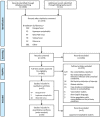Prevalence of chronic comorbidities in dengue fever and West Nile virus: A systematic review and meta-analysis
- PMID: 29990356
- PMCID: PMC6039036
- DOI: 10.1371/journal.pone.0200200
Prevalence of chronic comorbidities in dengue fever and West Nile virus: A systematic review and meta-analysis
Abstract
Background: Flavivirus diseases such as dengue fever (DENV), West Nile virus (WNV), Zika and yellow fever represent a substantial global public health concern. Preexisting chronic conditions such as cardiovascular diseases, diabetes, obesity, and asthma were thought to predict risk of progression to severe infections.
Objective: We aimed to quantify the frequency of chronic comorbidities in flavivirus diseases to provide an estimate for their prevalence in severe and non-severe infections and examine whether chronic diseases contribute to the increased risk of severe viral expression.
Methods: We conducted a comprehensive search in PubMed, Ovid MEDLINE(R), Embase and Embase Classic and grey literature databases to identify studies reporting prevalence estimates of comorbidities in flavivirus diseases. Study quality was assessed with the risk of bias tool. Age-adjusted odds ratios (ORs) were estimated for severe infection in the presence of chronic comorbidities.
Results: We identified 65 studies as eligible for inclusion for DENV (47 studies) and WNV (18 studies). Obesity and overweight (i.e., BMI> 25 kg/m2, prevalence: 24.5%, 95% CI: 18.6-31.6%), hypertension (17.1%, 13.3-21.8%) and diabetes (13.3%, 9.3-18.8%) were the most prevalent comorbidities in DENV. However, hypertension (45.0%, 39.1-51.0%), diabetes (24.7%, 20.2-29.8%) and heart diseases (25.6%, 19.5-32.7%) were the most prevalent in WNV. ORs of severe flavivirus diseases were about 2 to 4 in infected patients with comorbidities such as diabetes, hypertension and heart diseases. The small number of studies in JEV, YFV and Zika did not permit estimating the prevalence of comorbidities in these infections.
Conclusion: Higher prevalence of chronic comorbidities was found in severe cases of flavivirus diseases compared to non-severe cases. Findings of the present study may guide public health practitioners and clinicians to evaluate infection severity based on the presence of comorbidity, a critical public health measure that may avert severe disease outcome given the current dearth of clear prevention practices for some flavivirus diseases.
Conflict of interest statement
The authors have declared that no competing interests exist.
Figures



References
-
- Lindenbach BD, Thiel H-J, Rice CM. Flaviviridae: The viruses and their replication In: Knipe DM and Howley PM, ed. Fields Virology, 5th Edition. Philadelphia: Lippincott-Raven Publishers, 2007; 1101–1152.
-
- Hanley KA, Monath TP, Weaver SC, Rossi SL, Richman RL, Vasilakis N. Fever versus fever: The role of host and vector susceptibility and interspecific competition in shaping the current and future distributions of the sylvatic cycles of dengue virus and yellow fever virus. Infect Genet Evol. 2013; 19: 292–311. doi: 10.1016/j.meegid.2013.03.008 - DOI - PMC - PubMed
-
- Roehrig JT, Barrett ADT. Flavivirus infections in humans. eLS 2001; doi: 10.1002/9780470015902.a0002233.pub3 - DOI
-
- Mackenzie JS, Gubler DJ, Petersen LR. Emerging flaviviruses: the spread and resurgence of Japanese encephalitis, West Nile and dengue viruses. Nat Med. 2004; 10: S98–S109. doi: 10.1038/nm1144 - DOI - PubMed
-
- Petersen LR, Marfin AA. Shifting epidemiology of Flaviviridae. J Travel Med. 2005; 12 (Suppl 1): S3–S11. - PubMed
Publication types
MeSH terms
LinkOut - more resources
Full Text Sources
Other Literature Sources
Medical

